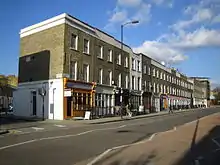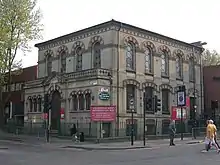Caledonian Road, London
The Caledonian Road passes for about a mile and a half north-south through the London Borough of Islington. It connects North London, from Camden Road near its junction with Holloway Road, and central London's Pentonville Road in the south. It is known colloquially as the "Cally" and forms the entirety of the A5203.

Character
The road is mostly residential from Camden Road until it reaches Caledonian Road Underground station. Residential developments have been constructed around the station including student accommodation. South of the station near the bridge carrying the North London Line is Pentonville Prison. South of the prison the road is lined with shops and cafes including several Ethiopian restaurants. The area is poor compared to the north end and the shops serve the council estates bordering the road and the more affluent Barnsbury area of mostly Georgian terraces to the east. The road crosses the Regents Canal at Thornhill Bridge and to the south are trendy shops and restaurants that have opened as a result of the King's Cross Central developments. The road ends at Pentonville Road near King's Cross railway station and the border with Camden. Housmans Bookshop, specialist radical book and magazine retailers established in 1945, is at No.5, as are the offices of Peace News and London Greenpeace, the people behind the McLibel Trial.
In August 2013, the railway bridge over the road was repainted to remove the word "Ferodo" (one of many such bridges advertising the company name) and replaced it with the street's informal name, "The Cally".[1] As of September 2016, Phil Coy's "your right to continued existence [cally colour chart]" was installed under "The Cally" bridge. The work illuminates the underside of the bridge with one colour at a time, with each colours name is simultaneously displayed on a dot matrix screen.[2]The pallet of 191 colour names were developed in consultation with local community groups with reference to the Caledonian Roads history.
The road was the subject of an hour-long episode in the 2012 BBC and Open University co-production, The Secret History of Our Streets, which chose the Caledonian Road as a typical London example. The road is mentioned in the song "Up The Bracket" by The Libertines.[3]
History
_b_089.jpg.webp)
The road was constructed in pursuance of an act of Parliament, 6 Geo. IV 156 (1825), obtained by the Battle Bridge and Holloway Road Company.[4] The company built the Caledonian Road in 1826 as a toll road to link the New Road with Holloway Road (which is part of the Great North Road) and provide a new link to the West End from the north.
Originally known as Chalk Road, its name was but changed after the Royal Caledonian Asylum for the children of poor exiled Scots, was built here in 1828. The building has since been demolished and its site is occupied by local authority housing, the Caledonian Estate built 1900-7.
The first residential buildings on the road were Thornhill Terrace (numbers 106-146) built in 1832, and other terraces were built in the 1840s. From around 1837 to 1849, cottages in gardens were built between Brewery Road and the site of the railway which were part of the failed Experimental Gardens or French Colony founded by a philanthropist, Peter Baume.[5] Due to poor lighting and roads, the cottages declined into slums.
Pentonville Prison was built in 1842 immediately to the south of the asylum. Cattle drovers passed along the road on their way to Smithfield until 1852 when the City of London Corporation transferred the Metropolitan Cattle Market to the Caledonian Market.[6]
In the mid 20th century, many communities were attracted to Caledonian Road by its relatively low property prices. An Irish community grew there; and in 1955, a cache of weapons belonging to the Irish Republican Army was discovered in the cellar of No. 257 Caledonian Road.[7]
Buildings

The road has a number of architecturally important or interesting buildings. Its listed buildings, include an Italianate Methodist Chapel built in 1870;[8] the Caledonian Estate, an early Edwardian flatted estate; Pentonville Prison;[9] and the Flying Scotsman, a 1901 public house and offices.[10] Caledonian Road Underground station is also Grade II listed.
University College London's controversial New Hall building attracted negative responses from some architectural critics on its completion for its purported failure to accommodate its Victorian facade with the building behind.[11] It was awarded the 2013 Carbuncle Cup for the ugliest building in the United Kingdom.[12]
The road passes Islington Council social housing estates such as Tiber Gardens.
Transport
Buses:
- 17: Archway - London Bridge
- 91: Crouch End - Trafalgar Square
- 274: Islington Angel - Lancaster Gate
- 259: Edmonton Green - King's Cross
- 153: Finsbury Park - Liverpool Street
References
- "Archived copy". Archived from the original on 4 March 2016. Retrieved 4 April 2014.CS1 maint: archived copy as title (link) CS1 maint: bot: original URL status unknown (link)
- your right to continued existence [cally colour chart]. "Art installation shines a light on The Cally's colourful past and present". Islington Council Media. Islington Council.
- Libertines. "Up The Bracket Lyrics". metrolyrics.com. Retrieved 10 June 2018.
- Wheatley, Henry Benjamin (1891). London, Past and Present: Its History, Associations, and Traditions. J. Murray. p. 317.
- Hibbert, Christopher; Weinreb, Ben; Keay, John; Keay, Julia (2011). The London Encyclopaedia (3rd ed.). Pan Macmillan. ISBN 978-0-230-73878-2.
- "Islington: Growth, Holloway and Tollington". British History Online. Retrieved 11 October 2017.
- Bullman, Joseph; Hegarty, Neil; Hill, Brian (2012). The Secret History of Our Streets: London. Ebury Publishing. ISBN 978-1-4464-1759-1.
- Historic England. "Details from listed building database (1205354)". National Heritage List for England. Retrieved 2 October 2015.
- Historic England. "Details from listed building database (1195491)". National Heritage List for England. Retrieved 2 October 2015.
- Historic England. "Details from listed building database (1195703)". National Heritage List for England. Retrieved 2 October 2015.
- Wainwright, Oliver (29 August 2013). "'Prison-like' student housing wins Carbuncle Cup for worst building". The Guardian.
- Woodman, Ellis (29 August 2013). "Carbuncle Cup winner 2013: A triumph for the dark side". Building Design. Retrieved 10 June 2018.
Sources
- Baggs, A P; Bolton, Diane K; Croot, Patricia E C (1985). "Islington: Growth, Holloway and Tollington". In Baker, T F T; Elrington, C R (eds.). A History of the County of Middlesex. Volume 8, Islington and Stoke Newington Parishes. London. pp. 29–37. Retrieved 10 June 2018 – via British History Online.
External links
![]() Media related to Caledonian Road at Wikimedia Commons
Media related to Caledonian Road at Wikimedia Commons